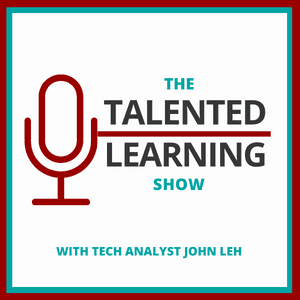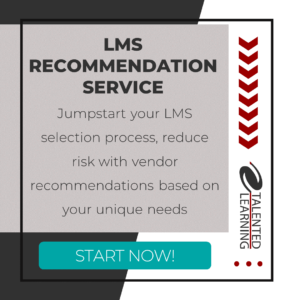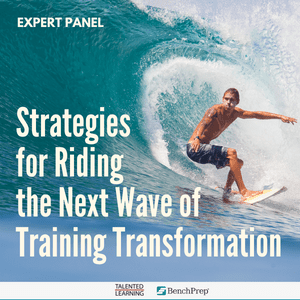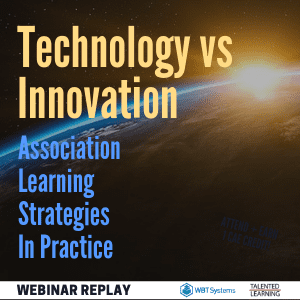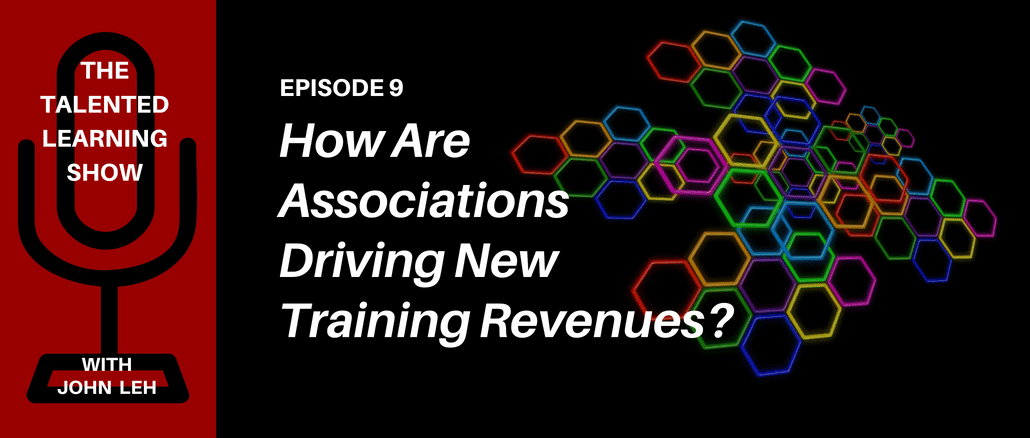
Podcast: Play in new window | Download
Subscribe: Apple Podcasts | Spotify | Amazon Music | Android | iHeartRadio | Blubrry | Email | RSS
WELCOME TO EPISODE 9 OF THE TALENTED LEARNING SHOW!
To learn more about this podcast series or to see the full collection of episodes visit The Talented Learning Show main page.
EPISODE 9 – TOPIC SUMMARY AND GUEST:
Associations everywhere are reinventing the way they engage and educate their members, thanks to ecommerce and LMS advances that help them drive new revenue streams from these strategies.
Today we talk with an expert who has been at the forefront of this movement for years – Linda Bowers. Linda is Chief Technology Officer at WBT Systems, a Dublin-based software company that focuses exclusively on association learning and certification solutions.
Because Linda spends much of her time gathering intelligence and feedback directly from customers, we often compare notes about industry issues and opportunities. We recorded our most recent discussion, so others who share our interest in association LMS trends can follow along.
KEY TAKEAWAYS:
- Many associations are seeking new sources of revenue from training and certification programs. Selling content to corporate customers through volume licensing is one increasingly popular approach.
- This kind of B2B opportunity promises significant upside. However, it can be complex to implement – with multiple business, process and technology considerations.
Q&A HIGHLIGHTS:
Your role as CTO is different from the traditional CTO role. It’s broader. Can you tell us about that?
My background is in LMS implementation. So as CTO, I’m obviously responsible for the roadmap, but I’m actively involved in the sales process because I like to learn directly about the problems organizations are trying to solve.
I also reach out to our existing customers fairly regularly to ensure that they’re happy and successful with their LMS implementation and to gather feedback about various aspects of our product. That’s important because customers are really the experts in what we’re trying to accomplish.
What do you see that’s different in 2018, from last year or even 2016?
Several things:
- More associations are extending their business models beyond delivery of training to individual members. Now they’re also selling content in bulk to businesses. Those are quite different models.
- In addition, associations are expanding their range of products and they’re enhancing the services they offer. For example, more organizations are offering certification programs and tying them to their learning programs and core offerings.
- We’re also seeing interesting techniques like gamification, digital badges and personalization moving forward quickly in the last few years.
When an association sells training to a business, how does that work?
Let’s say Company ABC has 100 employees, all of whom need similar training. So the association will contract directly with that company to provide learning content. And that brings a whole slew of considerations from an ecommerce perspective.
For example, will you need to agree to a contract in advance? What does that business model look like? Will you give them access to a library of courses … or will they pay as their users go … or are they buying content in bulk, as a bundle?
There are many ways you can approach it from a contractual and pricing standpoint. And of course, your systems must be flexible enough to support whatever business rules you choose.
Anything else?
You also have to look at things like how they’re going to pay for it. Is it an upfront payment? Do you have an agreement where they pay you retroactively? Is it staged? Do you want them to pay you separately through a financial system, so there may be integration points into the LMS? Or do you want the ecommerce system (if it fits into the LMS) to handle all of these payments?
Wow. And that’s just for the ecommerce piece of this. So how would Company ABC get users in the system?
User provisioning can certainly be a challenge. There are numerous ways to approach it. For example, ABC Company could be given access to a “corporate administrator.” This administrator can see available courses in the LMS and can send email invites to any employee.
So when a recipient clicks on a link in the email, it lets them effectively self-register, so they have immediate access to the system and the course. Whenever someone self-registers, it claims a seat from the bulk license.
And another scenario…?
You can swing from full self-service to a fully integrated approach. In that case, if you have an AMS or CRM, the users may all be preloaded.
Or you may receive an integration file from ABC Company, so you can preload the users into your AMS or CRM and have them dynamically called into the LMS, so they’ll be preregistered and email notices will automatically be sent to those users with course log-in details.
That makes sense…
You may also want to go a step further and offer a custom integration service. It really depends on the volume of corporate users and what level of self-service they desire.
So, can these bulk corporate transactions happen directly in the LMS, or does a representative finalize the contract, and then it’s entered administratively?
I’m seeing that capability moving online more frequently, particularly when associations are targeting relatively small businesses – say, when you want to bulk sell 50 seats, rather than 2000.
So, say we’ve sold 100 training paths to ABC Company. How is that tracked? Can an admin see that of 100 total licenses, 3 are assigned and 97 remain available?
We have a license tool that lets organizations set-up any licensing rules they wish. When users sign-up for courses, a dashboard tracks their status and content consumption. You can see how many people have claimed seats, and how many are actively consuming content within a specific license.
One simple thing people like about this is the ability to manage overflow. So for example, you may initially sell 100 licenses to ABC Company, but you can also agree that the license will accept additional users and ABC will be notified if demand exceeds their expectations.
So, say my association has sold 100 of these bulk licenses, and each has 100 learners. What does that delegated administrative responsibility look like?
Requirements vary widely. It could be as simple as administrators needing to assign training to each user and a basic dashboard to see user status. But it can go much further. The more associations get into this model, the more they find they’re not just selling courses to ABC Company, but they’re providing a mini-LMS solution, as well.
At that point, customers may need a domain within your LMS where they have access to content they’ve purchased from you, as well as the ability to import their own content and offer their own private dedicated catalog that incorporates their own branding, custom notifications and other functionality beyond the initial bulk content license…
TO HEAR EVEN MORE ABOUT B2B LICENSING MODELS AND RELATED TRENDS, LISTEN TO THE FULL PODCAST NOW!
WANT TO LEARN MORE? REPLAY THIS WEBINAR:
Technology vs. Innovation: Association Learning Strategies in Practice
AI. AR. VR. Digital breakthroughs like these are capturing headlines every day. Clearly, these innovations are promising. But many associations are focused on making the most of learning technologies that are already in place.
So how are these resourceful organizations actually transforming member learning experiences?
Join John Leh, CEO and Lead Analyst at Talented Learning, and Michelle Brien, VP Marketing at WBT Systems, as they explore real-world examples and discuss innovation strategies that will help you create lasting value. You’ll discover:
- The push/pull relationship between technology and change
- How to develop an innovation roadmap that works for your organization
- Tips for creating a business case your board will support
- How to avoid missteps when expanding your learning technology stack
- Guidelines for measuring results
Need Proven LMS Selection Guidance?
Looking for a learning platform that truly fits your organization’s needs? We’re here to help! Submit the form below to schedule a free preliminary consultation at your convenience.
[gravityform id=”18″ title=”false” description=”false”]



